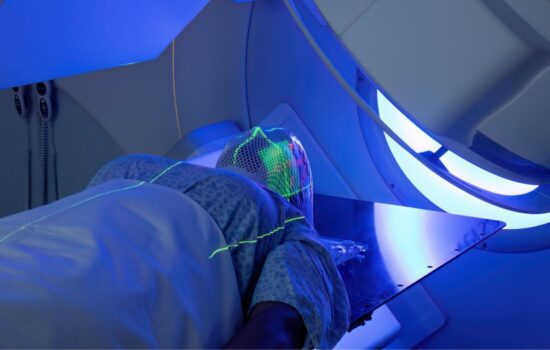July 12, 2024
About Radiation Therapy for Head and Neck Cancers

Cancers of the head and neck areas may require radiation therapy as part of the treatment process. This includes cancer in the sinus cavity, oral cancer, laryngeal and pharyngeal cancers, as well as cancer in the salivary glands.
For some patients, radiation therapy is the only treatment used, while others may receive a combination of radiation, surgery, and sometimes other treatments such as chemotherapy or immunotherapy.
Before creating a head and neck cancer treatment plan, your oncologist will review several factors, such as the type of cancer you have, its location, stage, and your current health. Based on this, the cancer care team determines if radiation is the right choice for you.

Understanding the Types of External Beam Radiation Used for Head and Neck Cancers
External beam radiation is one of the most common types of radiation treatments used for head and neck cancers. This treatment method requires you to lie still under a linear accelerator machine as the treatment is given. For the most precise treatment, your medical team will monitor your breathing so the radiation only enters your body when you’re not inhaling. This technique ensures that radiation goes only where it is needed.
Types of Radiation Therapy Used for Head and Neck Cancers
Intensity-Modulated Radiation Therapy (IMRT)
Intensity-modulated radiation therapy (IMRT) is sometimes used to treat head and neck cancers. This method involves imaging to plan the treatment process. Typically, this is done with a CT scan, but an MRI may also be used to locate the tumor and determine its shape and size.
Once the visual information about the tumor is gathered, your oncologist will create a customized treatment plan that sends beams of radiation to the specific location of the cancer, conforming to the shape of the tumor. IMRT is considered an effective treatment because it specifically targets the tumor while avoiding healthy tissue as much as possible.
If you undergo IMRT, you should expect to receive treatment five days per week for 4-8 weeks, which will be determined by the specifics of your head and neck cancer.
Image-Guided Radiation Therapy (IGRT)
IGRT, or image-guided intensity-modulated radiation therapy, relies on imaging to help create the best treatment plan. Common types of images include CT, MRI, or PET scans. The images are then combined with software that guides the radiation directly to the area for a more precise treatment.
This method relies on daily scanned images to determine an accurate delivery position. The images are also processed by software that maps changes in the size or location of the tumor. This information is then used to guide radiation delivery throughout the treatment.
Stereotactic Body Radiation Therapy (SBRT)
Stereotactic body radiation therapy (SBRT) delivers a high radiation dose during each treatment. It is most often used to treat laryngeal cancer because this targeted approach allows for a better chance of missing the vocal cords. In some instances, it may also be used to treat cancer that has returned. Patients should expect to have one to five treatments.
Stereotactic Radiosurgery for Head and Neck Cancer
Stereotactic radiosurgery (SRS) may be part of the treatment plan for head and neck cancers. It is often used for harder-to-treat areas and can be combined with other therapies for the best outcome.
SRS uses several radiation beams directed at the tumor. While it effectively kills the cancer cells, it does very little to the surrounding healthy tissue, making it a more targeted approach than other treatment options. Typically, SRS is given as a single treatment, but additional treatments may be required over a few days.
Internal Radiation Therapy for Head and Neck Cancers
Internal radiation therapy, or brachytherapy, is another treatment option sometimes used for head and neck cancers, namely for patients with recurrent cancer. High-dose-rate (HDR) brachytherapy is the most common method. The radiation is delivered through an applicator placed in or just outside the body, typically near the mouth. It is common for patients to undergo this treatment once or twice daily for two to five days.
Common Side Effects of Radiation for Head and Neck Cancers
Radiation treatment is incredibly effective at treating head and neck cancers, but there are some side effects that your medical team will work diligently to avoid as much as possible. Keep in mind there are many organs located in the head and neck area (such as the oral cavity and the salivary glands) that may be impacted by radiation, even if they aren’t the targeted area. Some possible side effects you may experience from radiation for head and neck cancer include:
Difficulty Swallowing: Sometimes radiation can cause a sore throat or inflammation, making it difficult to swallow for a period of time following treatment.
Tooth Decay or Loss: Teeth exposed to radiation are at risk of falling out or decaying. Your medical team will work with your dentist to minimize this risk as much as possible.
Dry Mouth: Radiation exposure can cause the salivary glands to stop working properly, which can then cause dry mouth. This side effect can be uncomfortable and may last a few days or be permanent. Some oral rinses may offer some relief.
Hoarseness: Radiation that comes in contact with the voice box can temporarily or permanently impact your voice. Often, the impact is based on how much radiation is given.
Reduced Thyroid Function: Your thyroid is located in the neck and, therefore, is more likely to be exposed to potential side effects that impact its overall function. Your care team will closely monitor your thyroid function following treatment to determine the best course of action to regain proper function.
Other radiation therapy side effects that are not specific to head and neck cancers include fatigue and skin irritation in the area where the radiation is directed.
While it is impossible to avoid all side effects of radiation treatment, your oncology team will monitor you closely and adjust your treatment plan as needed to ensure that you remain as comfortable as possible while in their care.
Head and Neck Cancer Treatment in Brevard County
There is no one-size-fits-all approach to creating a head and neck cancer treatment plan. At Cancer Care Centers of Brevard (CCCB), we understand the importance of treating each patient uniquely based on your needs. We provide our patients with a customized plan for their specific type and stage of head and neck cancer.
If you’re located in Brevard County, Florida, and will receive radiation therapy, it is important to choose a radiation oncology clinic close to where you live or work since you will frequently visit for treatment. Schedule an appointment with an oncologist at a CCCB location of your choice.
Categories: Head and Neck Cancers, Radiation Therapy